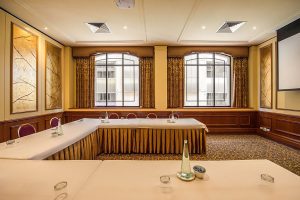One of the first steps to arranging a productive meeting is to ensure that the meeting room is suitable for attendees. While the size of the room may seem irrelevant, you must be aware that the right number of chairs, desks, and tables will be needed for everyone. It is advisable to avoid overcrowding the space. This will cause people to feel uncomfortable and impede the flow of the meeting. The larger the room, the more participants will be required to sit down.
 When choosing a meeting room, always keep the number of attendees in mind. For instance, if the meeting will be held daily, you should select a small room for a monthly or yearly meeting. The number of attendees and the number of supplies will affect the time required for the meeting. Also, the meeting room size must be suitable for the type of meeting. For example, if you hold a team meeting, you should choose a small room with comfortable seating.
When choosing a meeting room, always keep the number of attendees in mind. For instance, if the meeting will be held daily, you should select a small room for a monthly or yearly meeting. The number of attendees and the number of supplies will affect the time required for the meeting. Also, the meeting room size must be suitable for the type of meeting. For example, if you hold a team meeting, you should choose a small room with comfortable seating.
A meeting room should have enough space to accommodate all participants without causing distractions. It should not be located near the main lobby or facing a construction site. Soundproofing is another way to reduce distracting noise. The wall colour can also affect the overall productivity. For example, blue walls can be soothing, while red walls may be argumentative. The colour of the walls should reflect the image of your company. It should also be complementary to your brand.
The design of your meeting room should match the needs of the participants. It should be spacious enough for all to work comfortably. The room should be free from interruptions. You should avoid placing the room near the main lobby. Likewise, the meeting room should face a construction site. It should also be soundproofed. The wall colour can also affect your clients’ productivity. A blue wall evokes relaxed feelings, while red walls can make people argumentative. When selecting the colour of your meeting room, you must make sure it matches the rest of the building.
When it comes to the décor of your meeting rooms Adelaide, it should reflect your corporate culture and your goals. The furniture should be comfortable and convenient for all attendees. It should be easy to operate if the room is spacious. A well-designed room will encourage creativity. And it will set a good impression on the employees and clients of your company. A good choice of colours will make your staff feel comfortable. A room with a neutral colour will also promote productivity.
Moreover, you should consider the size of your meeting room. While the size of a meeting room is important, it should also be suitable for the number of participants. The larger the space, the more creative the participants will be. A large meeting room also allows them to explore and expand concepts. This way, the environment will be conducive to the productivity of employees. It will also create an impeccable impression for the clients. You should choose a room that fits the purpose of the meeting.
The size of your meeting room should be appropriate for the number of participants. It should be large enough to accommodate the number of participants. For example, if you have several people attending a conference, you may want to choose a room that is not too small. Ideally, a meeting room should be about three times the size of the most important person in the company. A small meeting room will be uncomfortable for the rest of the participants and will not serve its purpose.
The size of a meeting room is a crucial factor when deciding on a screen. The screen should be large enough for everyone to see the presentation but not be too large to overwhelm the room. Additionally, it should be placed at a reasonable distance from the audience.
It is important to ensure that a meeting room has sufficient space. It should not be too small. The room should be spacious enough for the number of people attending the event. It should also be free from distractions. If there is a construction site or the main lobby, choose a room away from the construction area. It should be soundproofed and indistinguishable from the rest of the building. You should also pay attention to the colour of the walls. For example, blue walls evoke a relaxed feeling, while red walls can make people feel aggressive.